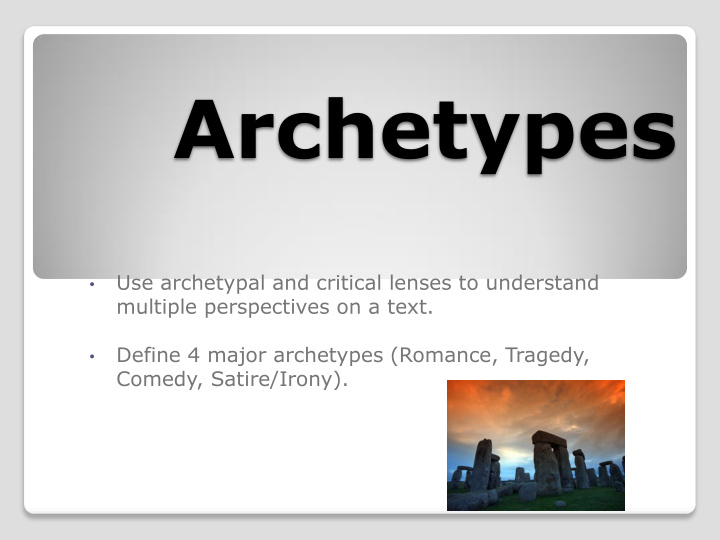



Archetypes Use archetypal and critical lenses to understand • multiple perspectives on a text. Define 4 major archetypes (Romance, Tragedy, • Comedy, Satire/Irony).
As a group, brainstorm the characteristics of the basic elements of a story. Hero Villain Conflict Steps leading to final showdown Resolution Small Group Activity
Archetypes are based on the theories of Carl Jung He believed that all humans shared what he called a “collective unconscious.” This “collective unconscious” consists of a knowledge base that all humans share containing ideas, images and emotional responses.
Jung described archetypes as: institutionalized patterns that recur in art across all cultures and all time .
This collective unconscious is to humans what instinct is to animals. Salmon know how to spawn without being told. People don’t need to learn everything; some things, we are just born knowing.
Archetypes can come in the form of stories, characters, and symbols. These symbols must be shared by different cultures OVER TIME to be archetypes. They must be universal .
Don’t confuse archetypes with other signs or symbols. A word or physical sign represents one object. U.S.A. NASA These signs are meaningless in themselves; they gain meaning through usage.
Symbols A symbol is something that stands for something else. This could be a letter, a character or a sign. Examples include the American flag a sheriff’s badge the Greek letter delta These objects are specific to a culture, a community and sometimes even to a specific text.
Take, for instance, a snake.
Put the snake in a time machine.
We can put the snake into the time and space machine and send it any place, at any time, an and peo d people ple wo woul uld agr d agree ee on on wha what th t that at snake means or represents…
Snakes are evil.
Hercules with snake in Ancient Greece
The feathered serpent Quetzalcoatl in Aztec culture
Lotan from Canaanite myths as a symbol of the seven deadly sins.
Shesha, in Hindu mythology, spews fire to destroy all creation.
Apep was the Egyptian Sun God. When he was replaced by Ra, he became very angry and evil.
Leviathan, the great sea monster
There are dragons (flying snakes) in both Chinese and Celtic mythology.
Then there is Medusa in Greek mythology.
In Norse mythology, Jormungandr will stain the soil and sky with his poison during Ragnarok (the end of the world).
Where can we find archetypes? Mythology Literature Art Religion Movies Comic Books Songs
Archetypes: Comedy Social group: strict or humorous society; setting out to reform Hero’s society prevails in end; reversal of social standards. Basic plot follows the movement from one type of society to another: existent to reformed. Premise: absurd or irrational law that must be broken ◦ A result of a rash promise or statement of obsessed tyrant, a powerful, but irrational character who can force much of society into his or her obsession
Archetypes: Comedy The change = inoffensive ◦ members of the original society reconcile with or convert into members of new society. ◦ An irreconcilable character may suffer a scapegoat ritual or expulsion. Existent Society Reformed Society Obstructing characters Hero and heroines Age, parents Youth, children Monetary wealth Monetary poverty Habit, ritual, ridiculous law Youth with sensible freedom Illusion (fixed, definable) Reality (not illusion, changeable)
Archetypes: Romance Marked by extraordinary nostalgia: a search for some kind of imaginative golden age in time or space. These stories typically have virtuous heroes and beautiful heroines who represent ideals and villains that threaten perfection Common plot is a basic quest: ◦ Struggle: perilous journey and minor adventures ◦ Ritual death: crucial struggle, usually a battle in which either the hero or his foe, or both, must die ◦ Recognition: the exaltation of the hero
Archetypes: Romance Often the hero will disappear after the ritual death and will reappear for the final stage. Resists subtlety and complexity: ◦ characters are either for or against the quest: those who assist are gallant or pure; those who obstruct are villainous or cowardly
Archetypes: Tragedy Focus on individuals: the tragedy in hero’s isolation, not villain’s betrayal Story begins with a hero who has comparatively free will and moves him or her into a world of causation ◦ This world is dependent on belief in natural law or fate ◦ does not necessarily attempt to answer questions about why these events happen; shows the effects of them. Basic tragedy begins with an Initial act: ◦ provokes revenge ◦ comes from or is transmitted through another world stretching the conception of nature and law beyond the visible world ◦ common for this act to occur before start of the story·
Archetypes: Tragedy ◦ Counterbalancing movement: an attempt is made to set the set things right ◦ Resolution: destruction is often spread beyond the individual hero At some point, the audience must be able to see two possible futures for the tragic hero: ◦ the one he could have had-- more or less happy and peaceful, and also the inevitable one. ◦ The hero cannot see both. Time brings the inevitable result: ◦ love and the social structure irreconcilable and contending forces; ◦ tragedy breaks up the family and opposes it to the rest of society.
Archetypes: Satire Mimics romance by applying romantic forms to more realistic content, which fits them in unexpected ways. Reality, rather than ideals, is dominant. Moral norms are relatively clear, and standards are assumed against which the grotesque and absurd are measured. ◦ Example: David and Goliath
Archetypes: Satire Two necessities of satire: ◦ wit or humor founded on imagination or a sense of the grotesque or absurd, and ◦ an object of attack. Founded on Convention ◦ All humor demands agreement that certain things, such as a picture of a wife beating her husband in a comic strip, are conventionally funny. ◦ To introduce a comic strip in which a husband beats his wife = not funny. Why?
Recommend
More recommend